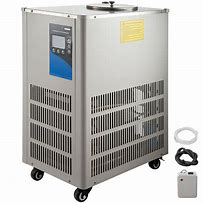A Laboratory chiller is a sort of cooling device used in research labs to take the heat out of apparatus or experiments. Also, It is intended to keep the temperature under strict control, guaranteeing reliable testing conditions.
Lab chillers use refrigeration technology to move a coolant through the system, typically water or a water/glycol mixture. It is a closed-loop system that consists of the chiller unit, the apparatus being cooled, and the experiment. The chiller unit cools the coolant before it is cycled after it absorbs heat from the apparatus or experiment.
Features & Applications
Lab chillers come in different sizes and cooling capacities to accommodate various types of equipment and experiments. They are commonly used in chemistry, biology, pharmaceuticals, and other scientific disciplines that require precise temperature control.
Working Principle of Laboratory Chiller
Pumped out of the chiller unit and into the apparatus or experiment, the coolant absorbs heat and returns it to the chiller unit. The coolant is then chilled, the heat is taken out, and it is circulated back to the apparatus or experiment. To keep the temperature steady, this process is continuously repeated.
In order to remove heat from the coolant, the chiller unit uses refrigeration technology. A refrigerant gas is normally compressed in order for it to condense into a liquid and release heat. In order for the liquid refrigerant to evaporate and absorb heat from the coolant, it is then expanded using an expansion valve. The cycle is then repeated after another compression of the refrigerant gas.
To manage the coolant’s temperature and guarantee accurate temperature control of the apparatus or experiment being cooled. The chiller unit has a number of parts, including a compressor, condenser, evaporator, expansion valve, and temperature controller.

